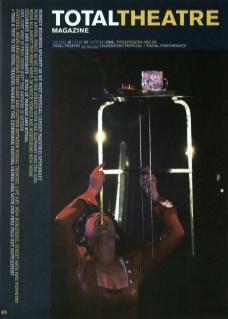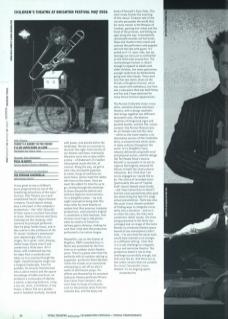It was great to see a children's piece programmed as one of the headlining attractions of the main Festival. Vélo Theatre are a well-established French 'object theatre’ company. Found objects always play a vital part in the company's productions – the 'vélo' (bicycle) of their name a constant from show to show. Charlot Lemoine and Tania Castaing are the company, with Lemoine its principal performer. Here he plays Tomás Snout, and in this role he is the antithesis of the TV-driven children's entertainer seen depressingly often on our stages. He is quiet, calm, dreamy, rather loopy (loony even!) and sometimes a little stern. All in black, with a battered top hat, he steps from a wardrobe and takes us on a journey through the night, transforming the stage into a magical landscape. From his pockets, his bicycle (transformed into a calico moon) and the sparse furnishings of table and drum, he produces a cornucopia of objects: a watch, a dancing ballerina, a key, a toy car, stars, a trombone, a tiny house, a fabric fish on a platter – each is handled carefully, invested with power, and placed within the landscape. We are on a journey to discover the night-time secrets of our dreams and fears; eventually the piece turns into a story within a story of Andersen's Tin Soldier (discovered inside the fish, of course). Along the way, we get to wear cosy winceyette pyjamas; to name, let go of and bury our worst fears; and to meet the rabbit who lives on the moon. Once we meet the rabbit it's time for us to go, exiting through the wardrobe to leave dreamtime behind and embrace daytime consciousness. It's a delightful piece – my only slight reservation being that this show relies far more heavily on spoken text than previous company productions, and Lemoine's English is sometimes a little hesitant, with stresses occurring in odd places: when he reverts to French his delivery gains vibrancy, making me wish that I had seen the production performed in his native tongue.
Meanwhile, out on the Streets of Brighton, DNA's reworked Puss in Boots was presented for the first time as an outdoor static theatre piece. There's a great start that fits perfectly with its outdoor setting as puppeteer performer Adam Bennett rallies the crowds as an auctioneer attempting to sell off an attic's worth of old theatre props. His efforts are thwarted by his assistant (physical theatre performer Miriam Grau Casas from Catalonia), who can't bear to let go of treasures such as the princess dress from the costume box, and the dusty red book of Perrault's Fairy Tales. This start nicely frames the enacting of the classic Trickster tale of the cat who persuades the world that his lowly master is the Marquis of Carabas, gaining him riches and the hand of the princess, and killing an ogre along the way. A wonderfully ramshackle wooden set has boxes, flaps and shutters that reveal and conceal the performers and puppets who tell the tale with gusto. It's aimed at 5-11 year-olds, but my teenage son was just as enthralled as the little ones around him. The carnivalesque humour is robust enough to appeal to adults and older children, but never patronises younger audiences by deliberately going over their heads. There were very few new static shows at the Streets of Brighton festival, which was awash with walkabout, but here was a new piece that was both feisty and fun and I hope destined for many future festival appearances.
The Persian Cinderella mixes circus skills, narrative drama and music theatre, with a design aesthetic that brings together two different decorative arts, the Western tradition of fairground signs and painted booths, and the flat-colour cartoon-like Persian Manuscripts. An all-female cast tell the story – which as the name implies is an alternative version of the Cinderella story, a universal tale which exists in many cultures throughout the world. It's a delightful story, robustly delivered using both word and physical action, and the design (by The People Show's Jessica Worrell) is successful in its aim to capture the brightly coloured 2D effects of both the cited cultural influences. But I find that I am not as engaged as I would like to be. The choice of recorded music, particularly the use of 'Capital Gold' classic female vocal tracks (did I hear Celine Dion in there?), and the corny pantomime jokes gave the whole thing the feel of a stage school presentation. There was also the usual circus-theatre problem of finding ways to integrate circus skills into a narrative – and as is so often the case, the links were sometimes rather clunky. The show being presented in the fairly low-ceilinged end-on stage of the Sallis Benney (a university theatre space devoid of any atmosphere) didn't help – I'm sure that the aerial work would have seemed a lot stronger in a different setting. I feel that it is a real challenge to integrate circus and narrative theatre. This production doesn't rise to that challenge successfully enough, but then very few do. And there are so few indoor venues that are suitable for circus! Successful circus-theatre: it's an ongoing quest.

